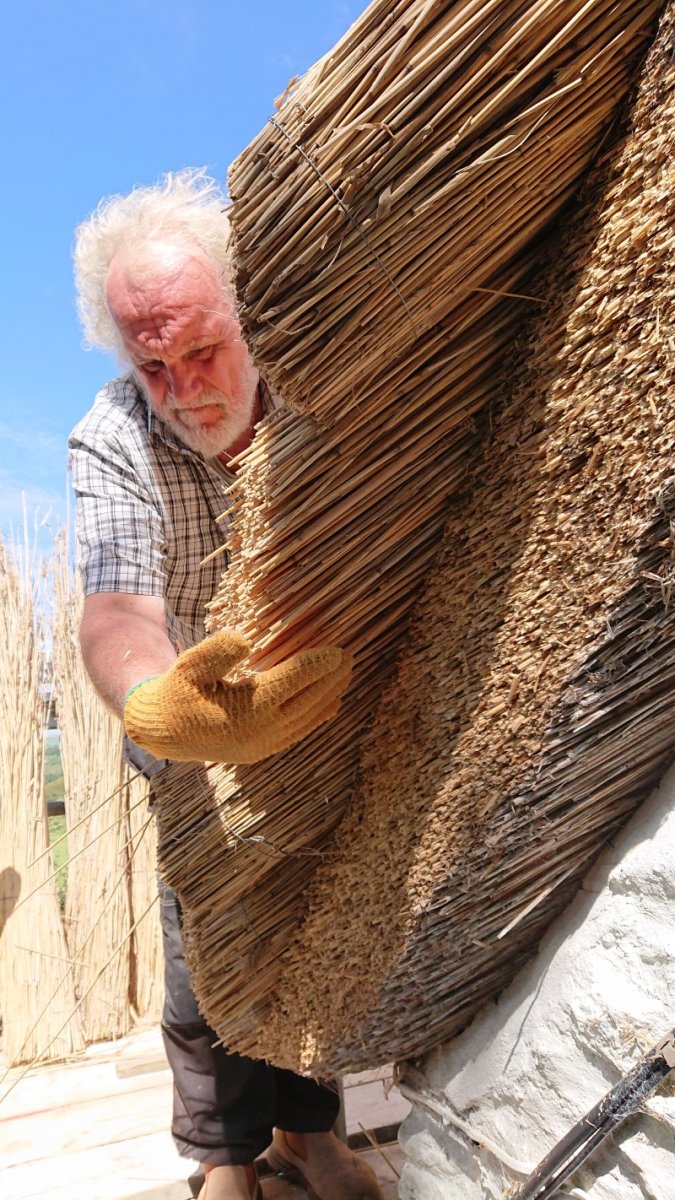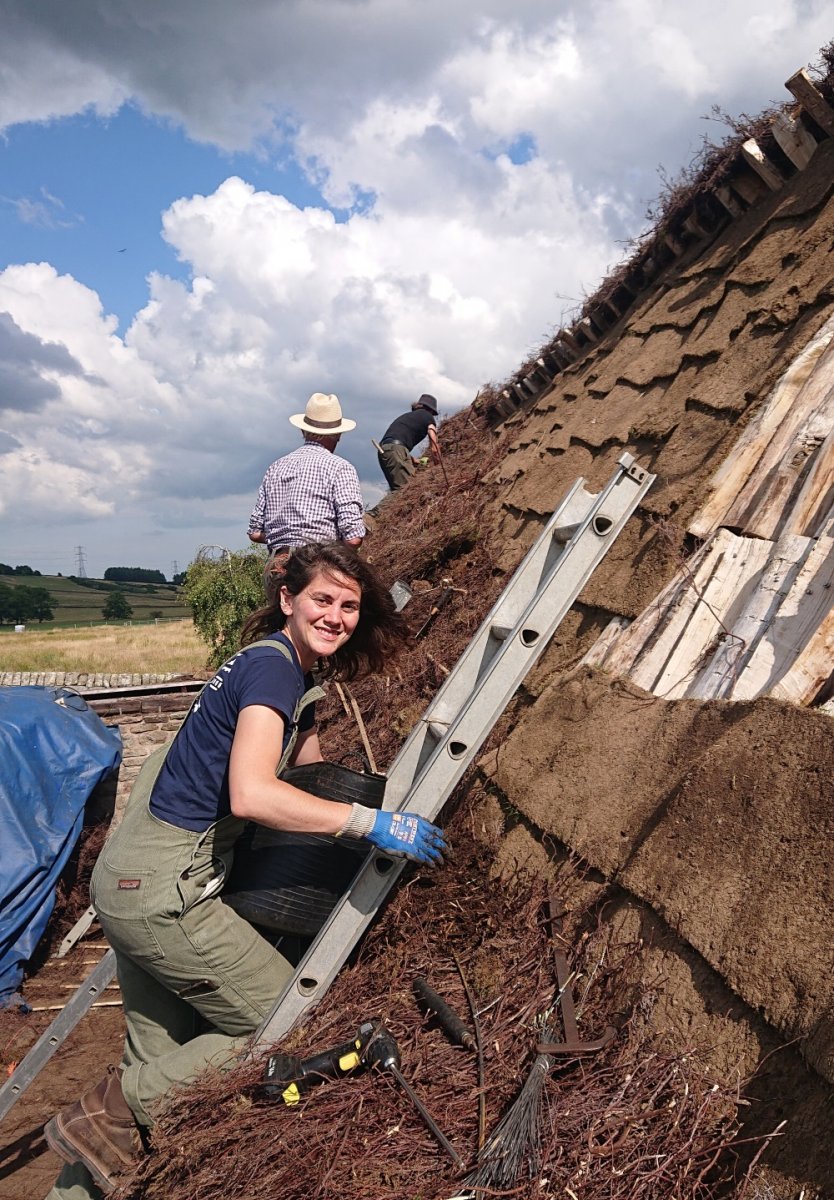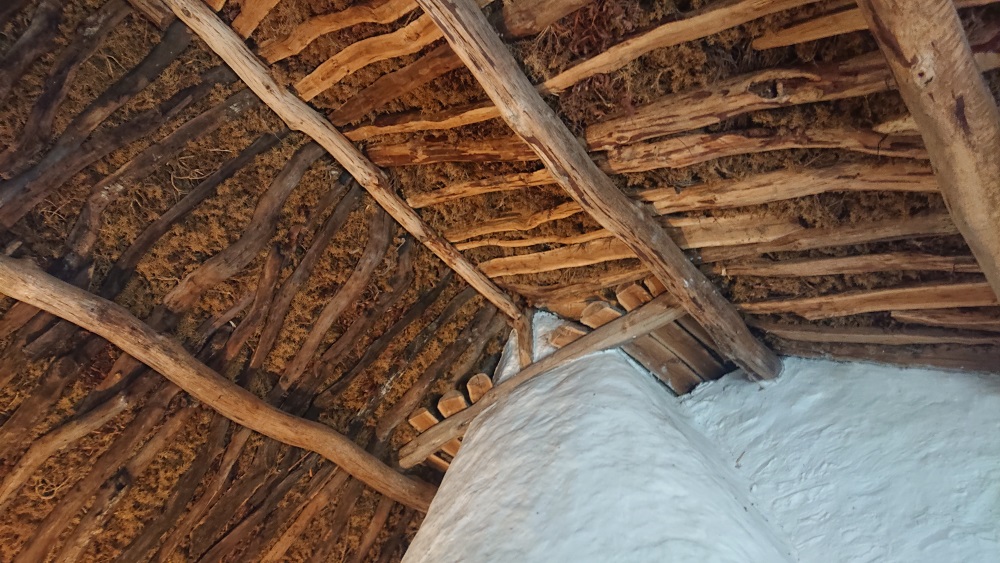SPAB Scholars: a new appreciation for thatching
Share on:
2021 Scholar Amy Redman shares her new-found love for a traditional craft and some of its challenges today...
In the last few weeks of the Scholarship we have been privileged to have seen this craft first hand and in as much depth as one or two days will allow. We have worked on actual roofs (!) with a few of the country's master thatchers: water reed thatching with Alan Jones in South Wales and heather thatching with William and Arthur Tegetmeir in Northumberland, culminating in a trip to Scotland to re-thatch the Goose Hut at Little Sparta, the garden of poet and artist Ian Hamilton Findlay.

Thatching history
The history of the materials and construction techniques is one that begins as far back as the Stone Age when simple buildings were covered in whatever suitable material grew locally to hand: straw, reed, heather, turf, rushes, wood chips and sedge. Historically thatching material was cheap and readily available depending on harvests and available labour. Thatching your roof and regular maintenance was carried out by the common folk and would have just been a natural and integral part of the living and working year. The techniques used for thatching were were refined over time. The methods we use now are truly a modern way of thatching (securing metal 'sways' with screw and wire fixings, for example) but the materials are still local, either in the natural landscape or which were 'waste' products from food production.
Changes over the centuries have meant a rise and fall in both the popularity and use of thatch. From the 17-19th century roof tiles became more popular and thatch was then only really found on more humble dwellings because it was cheap and relatively light in weight. In the first half of the 19th century the Welsh slate industry boomed; slates were relatively cheap and able to be transported throughout Britain on the new railways. Thatch became expensive and the wealthy built thatched buildings within their country estates to capture the cottage style. Most thatched roofs in England are now constructed with water or marsh reed, wheat reed or long straw.
Alan Jones thatching with water reed in Wales Scholar Lucy thatching in Northumberland. Credit: Amy Redman
Material challenges
Changes in food production and agriculture in Britain (mechanisation, type of crop and modern harvesting methods) mean thatching material, particularly long straw, is getting harder and harder to obtain. Alternatives have to be sourced. This has resulted in either a change of material (e.g. straw to water reed) or that materials have to be shipped from abroad. There are a few people in Britain who are still trying to maintain a source of thatching material at home (Alan Jones being one of them) but issues with growing and harvesting, as well as getting the right type of material sometimes mean a decision between sourcing materials elsewhere or just not being able to work. In the end there isn't really a choice.
What can we do?
Additional investment and education in a home-grown supply of thatch is needed now to ensure that Britain's stock of thatched buildings are maintained. There are obvious advantages to home-grown thatch. The quality, durability and strength of reed being grown in British climates is naturally ideally suited to British roofs. We can take advantage of landscapes where reed grows naturally; water reed cut every year or every two years yields a stronger crop and helps maintain the habitat for wildlife. Jobs are provided for local people and reduction in transport costs and carbon emissions is also a massive advantage. Might thatching have a resurgence in popularity as people become more environmentally aware? In terms of long straw, one way which is being considered is through collaboration with artisan bread makers and the production of building straw as a by-product from heritage grains. We can aim to return to more native and sustainable ways of both building and food production.
As thatch is now quite an expensive construction technique it no doubt puts people off from living in thatched buildings. Any way we can reduce the cost of thatching (whilst ensuring craftspeople are paid well for their skill and experience) will encourage thatched buildings to be retained but also that new thatch might be chosen as a roofing type in the future. We need people to be living in and looking after thatched buildings in order to keep them maintained and not ‘at risk’.
Traditional thatched buildings not only look beautiful they also tell us about the history of the building and provide an insight into past agricultural techniques through physical and biological archaeology. When renewing a roof, the under-thatch should be left on. This is the oldest, sometimes original thatch which may have evidence of smoke blackening and also may contain old or ancient grains, bugs, other plant life. The top layers of newer thatch are taken off to be replaced.
a historic roof in Wales. Credit: Amy Redman
Although at first glance more modern thatching material choices and construction methods may not seem true to the SPAB approach, this development of thatch currently and historically has been a direct result of the change in the country's production of local materials, people's taste and the available skills. It's another layer in the history of thatching in Britain. We now have the opportunity to make changes again. The choices that master thatchers have made means that Britain's stock of thatched buildings continue to be retained and maintained and with it the skill of craftspeople.
As building professionals we need to campaign for home grown thatch (and locally sourced vernacular materials in general!) to ensure that our buildings can be repaired so that they can be inhabited, studied and appreciated into the future. We need to support the few true master thatchers that remain to pass on their skills and knowledge. I would definitely go for a career change but I'm not sure that I’d be able to honour the skill, energy and passion we've seen from the thatching craftspeople we've seen on the Scholarship so far! Although I'd certainly give it a good go.
Sign up for our email newsletter
Get involved





